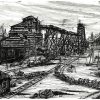A Year in Review: National Canal Museum Highlights
by Digital Engagement Specialist, Emily Rose Clayton
With the challenges that the COVID-19 pandemic has brought to museums, archives, and educational institutions across the country, virtual options have become an increasingly important option. Over the past year, the National Canal Museum has continued its commitment to growing and expanding our virtual and digital options, whether that be digital exhibits, showing off collection items through blog posts and social media – or a complete overhaul of our Tales of the Towpath companion website, and other virtual educational opportunities! As 2021 draws to a close, and we look forward to ringing in 2022, here’s a look back at a few highlights that will help you stay connected to the National Canal Museum. We look forward to seeing you in person when we re-open in April!
From our Collections:
 January 11: The Switzerland of America – Ephemera from the Switchback Railroad
January 11: The Switzerland of America – Ephemera from the Switchback Railroad
One hundred years ago, a popular tourist attraction was the “Switchback Railroad,” located in the “Switzerland of America,” at Mauch Chunk, PA (present day Jim Thorpe.) Originally designed to move coal from the Summit Hill mines to the Lehigh River at Mauch Chunk (present day Jim Thorpe), the Switchback Railroad was an engineering marvel.
 February 1: 1864 Rules and Regulations of the Lehigh Canal
February 1: 1864 Rules and Regulations of the Lehigh Canal
At first glance, carrying cargo up and down the Lehigh Canal seems to be a fairly straightforward operation – but canal-boat captains were actually highly skilled operators who were trained to avoid trouble on the waterways. To keep everything running smoothly, the canal had a strict set of rules and regulations, seen in a broadside from 1864.
August 11: From the Lehigh Valley to the Panama Canal
Atlas Portland Cement, manufactured here in the Lehigh Valley, was instrumental in constructing one of the greatest engineering marvels of its time – the Panama Canal. On August 15, 1914, the S.S. Ancon passed from the Atlantic to the Pacific via the Panama Canal—the first ship to make the transit. Aboard were 200 dignitaries, a far cry from the millions of bags of cement and the hundreds of workers that the Ancon and her sister ship, the S.S. Cristobal, had hauled from New York to Panama since 1909 for the construction of the canal.
Stories from the Corridor:
 March 11: The Women of the Silk Mills
March 11: The Women of the Silk Mills
The Silk Industry in the Lehigh Valley was the first major industry to employ women. Though there was at least one silk mill in every county in the Commonwealth, the industry was concentrated between the Delaware and the Susquehanna. One-third of all American silk workers were Pennsylvanians and 60% were female.
 February 17: Captain Jimmy Brown – African-American Canal Boat Captain
February 17: Captain Jimmy Brown – African-American Canal Boat Captain
In the summer of 1910, at the age of 10, James “Jimmy” Brown ran away and started driving mules for a canal boat captain. By the age of 15, he became a captain with his own boat, and continued to run boats from as far north as Mauch Chunk to as far south as the eastern Shore of Chesapeake Bay in Maryland. Captain Brown’s oral histories, audio recordings in 1982 and a 1991 video, are invaluable records of a unique way of life as well as of the last decades of anthracite canal navigation.
June 9: Stephen Crane’s Visit to an Anthracite Mine 
In 1894, while waiting for McClure’s Magazine decision on whether or not to serialize The Red Badge of Courage, Stephen Crane accepted an assignment from the year-old periodical to visit and write about an anthracite mine near Scranton. Though this was nearly a decade before McClure’s became the cradle of muckraking journalism under Lincoln Steffens, “In the Depths of a Coal Mine” was a graphic indictment of the difficulties, dangers, and stark horrors of work in the anthracite mines and breakers.
Digital Exhibits:

On April 1, 1921, the “Individual Drinking Cup Company” – which would later be known as Dixie – moved into an 80,000 square foot building in Wilson, PA, becoming an integral part of the corridor’s industry. Click through to learn more about the company, and the women who made production possible.
 History of the Delaware & Lehigh National Heritage Corridor: Photographic Timeline
History of the Delaware & Lehigh National Heritage Corridor: Photographic Timeline
The abundant natural resources made the Corridor an important area of production in the years before the American Revolution, and the discovery of Anthracite Coal launched mining and transportation which helped shape the Industrial Revolution in the United States. The Lehigh and Delaware canals, and the industry which grew around these transportation corridors, played a very important role in shaping the area and forming it into what we know and see today.
 Death of a Giant: The Last Cast at Bethlehem Steel
Death of a Giant: The Last Cast at Bethlehem Steel
In commemoration of the 25th anniversary of the “Last Cast,” we are proud to present the following digital exhibit, “Death of a Giant: The Last Cast at Bethlehem Steel.” This digital exhibit is adapted from the fascinating pictorial history, Bethlehem Steel in Bethlehem, Pennsylvania, available for purchase at the National Canal Museum, the National Museum of Industrial History, or online here.
“Meet Our Mules!” may not be something you expect to hear when you visit a museum, but here at the National Canal Museum, our friendly “engines” for the Josiah White II canal boat work alongside our crew of historical interpreters to tell the story of the anthracite canals and the people who worked and lived on them.
Museum at Home/Virtual Education
 When you can’t come to the museum, we bring the museum to you!
When you can’t come to the museum, we bring the museum to you!
Kids (and the young at heart) will find plenty of activities on our Museum at Home: Kids on the Canal page. Adults and those who want to dive even deeper into local history will enjoy watching the videos and reading through the blogs on the Museum at Home: Adult Education side. We hope you enjoy our digital museum at home!

Virtual Education and Educational Visits
Are you a teacher, scout leader or part of a homeschool cooperative?
Check out our new and expanded Virtual Education Options!
The Delaware and Lehigh National Heritage Corridor and National Canal Museum offers in-person and virtual educational experiences for groups of up to 150. Whether you are looking for a full-day field trip or a one-hour visit to the museum, we have options for you. Do you want your experience customized to your learning objectives? We can do that!

Newly Revamped: Tales of the Towpath
Tales of the Towpath is the Delaware and Lehigh National Heritage Corridor and National Canal Museum flagship education program. Standardized third through fifth grade social studies/ language arts curriculum. Visit the completely new companion website to access historical and educational info, photos, maps, quizzes, Amulet side quests, and other activities for students as they read Finn Gorman’s story.

























Join the Conversation!